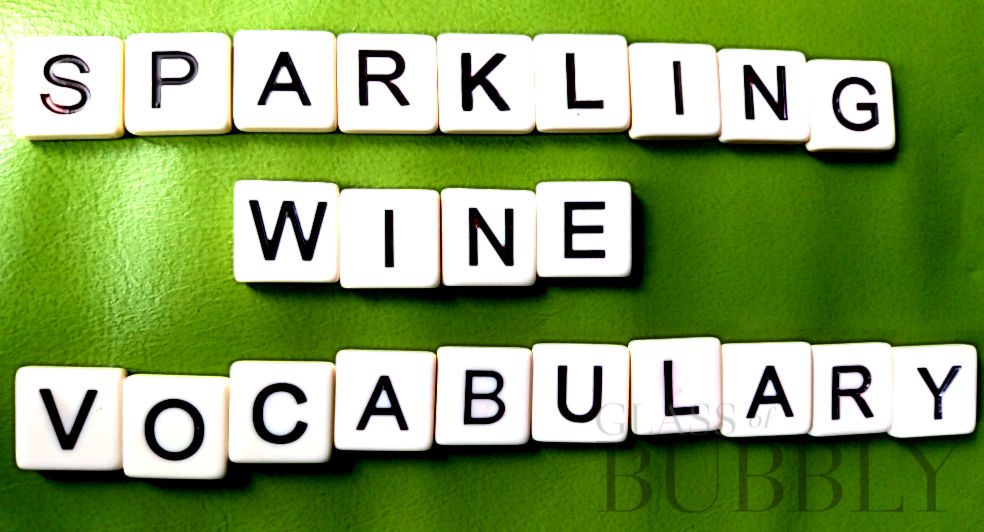Sparkling Wine Vocabulary
2nd February 2023

I certainly agree that wine is to be enjoyed and we do not always want to engross ourselves too much on the ins and outs of the science behind how it arrived in the glass we are sipping from. There are books written on certain wine regions and even dedicated to wineries which I am sure we do not wish to recite prior to popping open the bottle and pouring!
As James May tells Oz Clarke, when it comes to learning about wine, he simply ‘wants to taste the wines so to appreciate them’, not endlessly talk about them!
Even though there is nothing better than enjoying the wine in your glass, and maybe we can add a notch or two when it is sparkling wine, should we wish to understand the wine better we have to resort back to the usage of words, some of which may stray outside of our everyday vocabulary. I think it a good idea that we take a look at vocabulary in sparkling wine, some of which are French words, that we should have knowledge of so at least we can impress our friends and family the next time we are enjoying a glass of bubbly. Including phrases, we hope the below acts as a wine vocabulary resource for you:
Tirage: This is part of the process of making sparkling wine when sugar and yeast is added to wine (blend) so to induce secondary fermentation within the bottle.
Muselet: This is the metal wire cage that fits around the top of a sparkling wine bottle that secures the cork in place.
Lees: The all important sediment (dead yeast cells) that forms within the bottle during the second fermentation process. Many people prefer that the lees stays in the bottle longer so to give stronger yeast / bread / nutty characters.
Liqueur de Tirage: This is an additional mix of wine / sugar / yeast that is added to still wine to stimulate the second in-bottle fermentation and producing the carbon dioxide for sparkling wines.
Perlage: The ‘formation of pearls’ / ‘finest pearls’ which references the bubbles forming on and rising from the bottom of your glass of sparkling wine.
Traditional Method: The term used to classify sparkling wines which are bottle-fermented.
Charmat (Method): The bubbles are created within the tank prior then the bubbly wine is bottled under pressure.
Remuage / Riddling: This is the action of turning the bottles (manually or by machine) of traditional method sparkling wine which have sediment (lees) so that they are drawn down to the neck of the bottle and ready to be removed (disgorgement).
Dosage / Liqueur D’Expedition: After the Lees has been ‘disgorged’ some of your Champagne or Sparkling Wine may escape from the bottle, you will quickly need to fill the bottle back up to the right amount using some of your original Cuvée.
Dry: In sparkling wine terms this means sweeter, ie Extra Dry will be sweeter than Brut, 0-12 g/l for Brut and 12-17 g/l for Extra Dry.
Champagne Blend: Used mostly within the Champagne region though also adopted as a descriptive word elsewhere in regards to the grapes used within the blend: Chardonnay, Pinot Noir and Meunier.
DOC: An Italian classification within the wine category (Denominazione di Origine Controllata) of what is recognised as standard quality produced within controlled regions.
DOCG: An Italian classification within the wine category (Denominazione di Origine Controllata e Garantita) of what is recognised as superior quality produced within controlled regions.
Grand Cru: Translated from French its meaning is ‘great growths’ and the wines are classified as the best within a selected few areas (villages).
Premier Cru: Translated from French its meaning is ‘first growth’ and the wines are classified as good standard within selected areas (villages).
Saber: Though the meaning of Saber is simply a heavy cavalry sword with a one-edged, slightly curved blade, the verb to saber in relation to sparkling wine is the action of striking the bottle top so causing it to separate and release the wine within.
Disgorge: The action of disgorgement is the removal of the dead yeast cells from a bottle prior to the bottle receiving a cork in readiness to be sold.
Non Vintage (NV): A sparkling wine will contain a blend from multiple years (harvests).
Vintage: All the grapes used to make the sparkling wine will have come from a single year (harvest).
New World: Refers to sparkling wines produced outside the traditional winegrowing areas of Europe and the Middle East such as New Zealand, Argentina and South Africa.
Old World: Refers to sparkling wines produced within the traditional winegrowing areas of Europe and the Middle East such as Italy, France and Georgia.
Brut: The most common style of sparkling wine produced and refers to the ‘sweetness level’ with anywhere between 0-12 grams of sugar per litre.
![]()
Christopher Walkey
Co-founder of Glass of Bubbly. Journalist and author focused on Champagne & Sparkling Wines and pairing them with foods.
